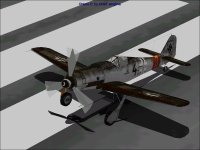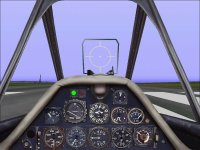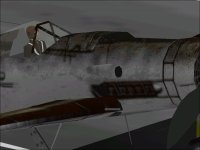Here is another old project that fits pretty well into the Diversion category.
This FW 190D-9 AFX was done by Alex Simon and seems to be the basis for numerous FW 190D and Ta 152 projects out in the CFS menagerie.
This is not the first time I have looked at making corrections to this project.
While the basic appearance of the finished aircraft especially those with textures by Hugh Shoults actually looks pretty good, there are plenty of hidden boogers that are very hard to correct.
From what I can tell, folks working with this project haven't generally tried to make any great corrections to it other than to move the Supercharger Intake from the Port to the Starboard side more typical of a JuMo engine.
As far as I am concerned, this project is pure experimentation and will never lead to a release of any kind.
If I want a FW 190 with an inline engine, it will be a conversion of my own FW 190A project.
At least there, I have a pretty good idea how big the can of worms is before I open the can.
This AFX was done before the rather casual SCASM edits we now throw in without much thought.
There are a few almost hidden parts near the CoG of the Model that are textured to almost provide a virtual cockpit.
I say "almost" because they don't really align with the other pieces of the model but at least they don't leave the model looking like a hollow shell in Quick Combat. Some of the other FW 190D based on this AFX actually use this feature.
Since I know that SCASM works better for the purpose, I decided to remove these pieces.
This brings up another bit of strangeness with this AFX and the zip file containing it.
Although the Assembly had the Parts and they were textured, they did not show as textured in AF99.
Also, the textures that were used by these pieces were not included in the zip file.
I could easily pull them from any number of other FW 190D downloads, but thought it was such a goofy way of doing things, that it was not worth the effort.
I decided to simply remove those pieces from the Assembly.
One might notice in the screenshot that nothing is animated.
This is because in removing those virtual cockpit pieces, the model was changed enough that Aircraft Animator no longer recognizes the pieces it is supposed to animate.
This brings up another point. Has anyone else wondered how Aircraft Animator recognizes pieces that it needs to animate?
I found out a year or two ago that it is actually by the SCASM label for the pieces. (!)
As long as the AF99 edits don't change those labels, prior animated pieces will be recognized (mostly).
So why am I still wasting time on a project that I know will go nowhere?
There are a few things that are done in this project that I never do on my own projects.
I can experiment with those features to see if I can improve them to the point where they become a reasonable thing to add to my own projects. If I fail and damage something, it was a throwaway project anyway and these assemblies tend to be much less complicated than ones in my projects.
It is also very satisfying to make a few simple changes and see some noticeable improvements.
- Ivan.
This FW 190D-9 AFX was done by Alex Simon and seems to be the basis for numerous FW 190D and Ta 152 projects out in the CFS menagerie.
This is not the first time I have looked at making corrections to this project.
While the basic appearance of the finished aircraft especially those with textures by Hugh Shoults actually looks pretty good, there are plenty of hidden boogers that are very hard to correct.
From what I can tell, folks working with this project haven't generally tried to make any great corrections to it other than to move the Supercharger Intake from the Port to the Starboard side more typical of a JuMo engine.
As far as I am concerned, this project is pure experimentation and will never lead to a release of any kind.
If I want a FW 190 with an inline engine, it will be a conversion of my own FW 190A project.
At least there, I have a pretty good idea how big the can of worms is before I open the can.
This AFX was done before the rather casual SCASM edits we now throw in without much thought.
There are a few almost hidden parts near the CoG of the Model that are textured to almost provide a virtual cockpit.
I say "almost" because they don't really align with the other pieces of the model but at least they don't leave the model looking like a hollow shell in Quick Combat. Some of the other FW 190D based on this AFX actually use this feature.
Since I know that SCASM works better for the purpose, I decided to remove these pieces.
This brings up another bit of strangeness with this AFX and the zip file containing it.
Although the Assembly had the Parts and they were textured, they did not show as textured in AF99.
Also, the textures that were used by these pieces were not included in the zip file.
I could easily pull them from any number of other FW 190D downloads, but thought it was such a goofy way of doing things, that it was not worth the effort.
I decided to simply remove those pieces from the Assembly.
One might notice in the screenshot that nothing is animated.
This is because in removing those virtual cockpit pieces, the model was changed enough that Aircraft Animator no longer recognizes the pieces it is supposed to animate.
This brings up another point. Has anyone else wondered how Aircraft Animator recognizes pieces that it needs to animate?
I found out a year or two ago that it is actually by the SCASM label for the pieces. (!)
As long as the AF99 edits don't change those labels, prior animated pieces will be recognized (mostly).
So why am I still wasting time on a project that I know will go nowhere?
There are a few things that are done in this project that I never do on my own projects.
I can experiment with those features to see if I can improve them to the point where they become a reasonable thing to add to my own projects. If I fail and damage something, it was a throwaway project anyway and these assemblies tend to be much less complicated than ones in my projects.
It is also very satisfying to make a few simple changes and see some noticeable improvements.
- Ivan.
























